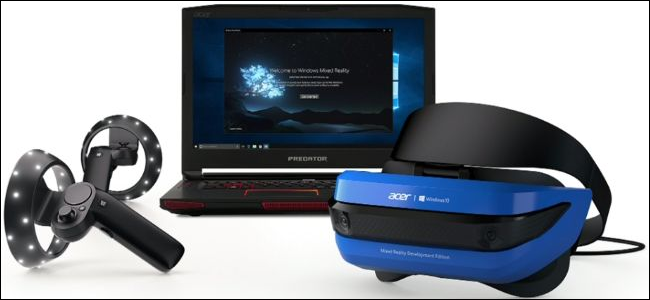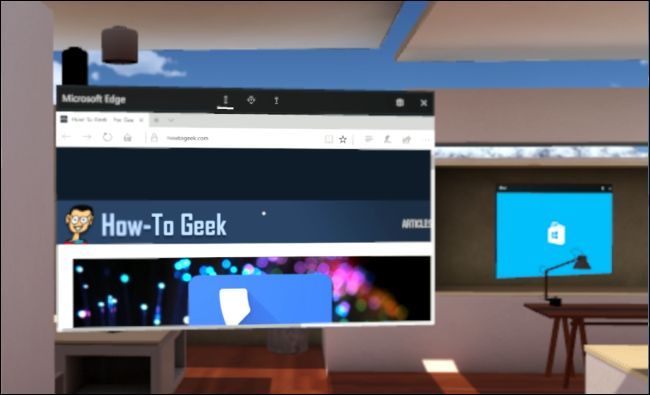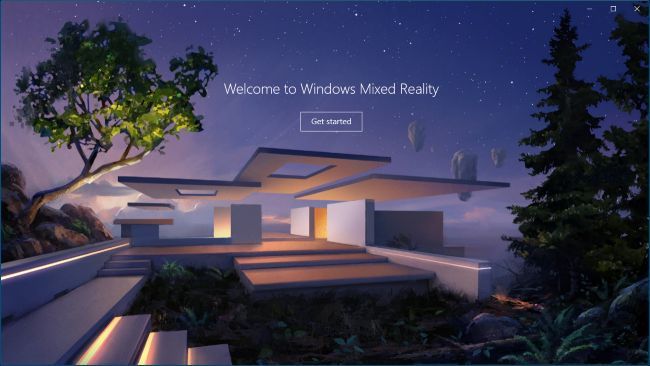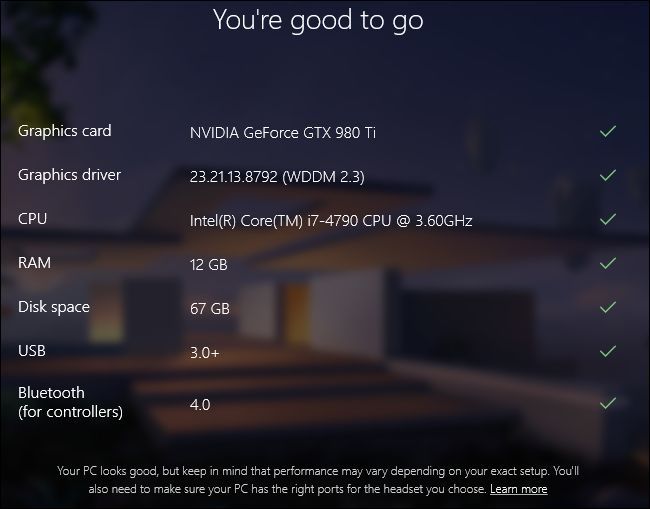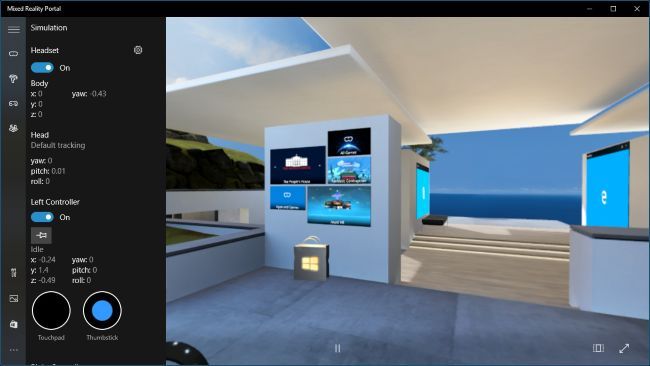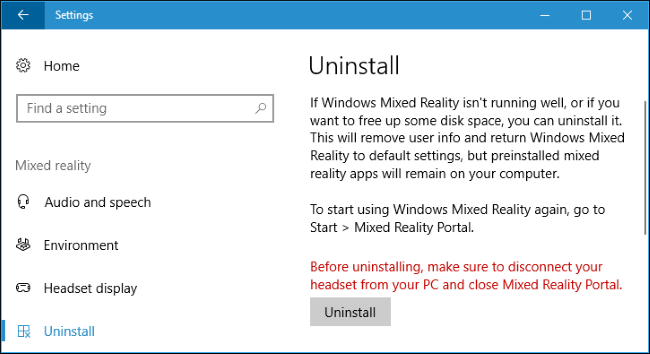Quick Links
Microsoft is building an ecosystem of "Mixed Reality" headsets from various PC manufacturers. Despite the misleading name, the first headsets you can buy today are really just virtual reality headsets, with no augmented reality features at all.
These devices were originally designed to be less expensive than the Oculus Rift and HTC Vive, but the Oculus Rift now costs $399, which is the same price as the cheapest Mixed Reality headsets. They're a bit faster to set up and require less powerful PC hardware, but don't have much else to offer over the big names yet.
The Dream: What "Mixed Reality" Might Be In The Future
"Mixed Reality" is the new name for "Windows Holographic", a Microsoft platform that will power a wide range of different headsets, including Microsoft's HoloLens. According to Microsoft, it was renamed Mixed Reality because it includes augmented reality, virtual reality, and holographic computing.
Augmented reality involves placing objects over the real world. You'll still see the real world, but those virtual objects will appear over it---think Pokémon Go, but in a headset (and hopefully better).
Virtual reality headsets don't display the real world. Headsets like the Oculus Rift, HTC Vive, PlayStation VR, and Samsung Gear VR work like this today, offering screens that show you a virtual world without the real world being visible.
Holographic computing involves holograms---like on the HoloLens, which Microsoft calls "the first self-contained, holographic computer".
The Reality: What "Mixed Reality" Headsets Are Today
That all sounds pretty cool, and maybe it will be one day. But you can't get those features today with the first generation of these Mixed Reality headsets. Despite the name, they're actually just virtual reality headsets. There's no sort of augmented reality features here. If you want those, you'll still need to pay $3000 for a HoloLens.
Microsoft originally announced these headsets would include built-in cameras, so they could perform augmented reality tasks by overlaying a video of the real world from the outside of your headset. That didn't happen, and none of these headsets have cameras.
Valve is working on SteamVR support for Windows Mixed Reality headsets, which means you should one day be able to use them with virtual reality games on Steam, just like you can with an HTC Vive or Oculus Rift. Until then, you have to get applications designed for Windows Mixed Reality from the Store. You can download a few 360-degree video players and some big games compatible with other VR headsets like Space Pirate Trainer, Superhot VR, and Arizona Sunshine, but you're not getting anything special you can't find on other headsets.
Ultimately, the first generation of Mixed Reality headsets are a new type of virtual reality headset like that Oculus Rift or HTC Vive. Microsoft touted them as more mainstream, being cheaper and running on less powerful hardware than those gaming-focused headsets. However, while they're cheaper than the HTC Vive, they're now basically the same price as the Oculus Rift. And, while they can run on less powerful hardware than the Rift at the cost of graphical detail and smoothness, we imagine most people who want to spend $399 on a virtual reality headset will probably have decent PC hardware to use it with.
What You'll Be Able to Do in Mixed Reality (One Day, Maybe)
In theory, Mixed Reality will be an entire application platform that apps and games of various types can use. One day you may find everything from 360-degree videos and social networking to action games and virtual tours of the real world. Developers would be able to create any apps or games they like, just as they can for other platforms.
Microsoft also showed off creating a custom space and decorating it with your own furniture, holograms, and apps. Mixed Reality supports those new Universal apps you can get in the Windows Store. For example, you could have an app icon sitting on a shelf you launch, or you could have a floating window representing the app.
This is designed to work either with augmented reality or holographic headsets, where you'll see the objects superimposed over the real world, or a virtual reality headsets where you'll have a virtual room.
Again, this is just how Microsoft pitched it. This first generation of Mixed Reality headsets don't have any augmented reality features at all. So you'll just be doing this all in a "virtual home" unless you buy a HoloLens or wait for more capable Mixed Reality headsets that may be released in the future.
You Can Buy a Headset Today, But the Price Doesn't Make Sense
With the launch of the Fall Creators Update, a variety of Mixed Reality headsets are now available for purchase. You can buy headsets created by Acer, Dell, HP, Lenovo, and Samsung. Each headset is available as a bundle with handheld motion controllers.
The Acer and Lenovo bundles cost $399, the Dell and HP bundles cost $449, and the Samsung bundle costs $499. Meanwhile, an Oculus Rift bundle that combines a headset and touch controllers costs $399. The only way you'll save money over an Oculus Rift is by purchasing a Mixed Reality headset for $299 without the controllers, and that would really be missing the point. The motion controllers are a crucial part of the experience.
While this is still cheaper than the $599 HTC Vive bundle, the Mixed Reality headset prices don't make much sense. At the same price as an Oculus Rift---or even more expensive, for some of the headsets---and with less software support and worse graphics, there's little reason for most people to buy these over a Rift. Developers who want to develop applications for Microsoft's Mixed Reality platform and enthusiasts who really want to play with this new stuff might be interested, but that's it.
One distinguishing feature of these headsets versus the Oculus Rift and HTC Vive is that they have something called "inside-out tracking". In other words, the headset itself has cameras and sensors that can track its orientation and position in space. On the Oculus Rift and HTC Vive, you have to set up separate cameras that look at your headset to track its position. This means these Mixed Reality headsets are faster to set up. On the other hand, we'd expect this inside-out tracking to be less precise, and early reviews seem to agree that it is.
Another distinguishing feature is that they can run with less PC horsepower. You can even use Mixed Reality headsets on a laptop with some types of Intel integrated graphics. However, the high-end "Mixed Reality Ultra" experience requires about the same hardware as an Oculus Rift or HTC Vive.
There's no magic here: Mixed Reality headsets can function on less powerful hardware, but the graphics won't be as detailed and, more importantly, the frames per second (FPS) will be lower. Oculus Rift and HTC Vive games often target 90 frames per second and the Mixed Reality Ultra hardware is designed to provide 90 frames per second as well. However, when running on the less powerful minimum hardware, Microsoft says you should expect 60 frames per second. This will make the experience less smooth and may even cause "virtual reality sickness" or discomfort in some people---everyone is different.
What PC Hardware You'll Need
There are two different tiers of hardware requirements. There's the standard minimum hardware requirement and an "Ultra" hardware requirement for maximum performance and graphics quality.
The minimum hardware requirements don't require the same powerful gaming PC hardware the Oculus Rift and HTC Vive need. They are:
- CPU: Intel Core i5-7200U (7th generation mobile) dual-core with Hyperthreading (or better)
- GPU: Integrated Intel HD Graphics 620 (or greater), NVIDIA MXX150/965M (or greater)
- Connectivity: HDMI 1.4 or DisplayPort 1.2
- RAM: 8GB DDR3 dual channel (or better)
- HDD: 10 GB of free space
- USB: USB 3.0 Type-A or Type-C
- Bluetooth: Bluetooth 4.0 for motion controllers
You can expect performance of 60 frames per second with the minimum configuration.
For Ultra PCs, the hardware requirements are very similar to the Oculus Rift and Vive. They are:
- CPU: Intel Core i5 4590 (4th generation) quad core (or better), AMD Ryzen 5 1400 3.4Ghz desktop quad core (or better)
- GPU: NVIDIA GTX 960/1050 discrete GPU (or greater), AMD RX 460/560 (or greater). GPU must be in a PCIe 3.0 x4+ Link slot.
- Connectivity: HDMI 2.0 or DisplayPort 1.2
- RAM: 8GB DDR3 (or better)
- HDD: 10 GB of free space
- USB: USB 3.0 Type-A or Type-C
- Bluetooth: Bluetooth 4.0 for motion controllers
You can expect performance of 90 frames per second with the Ultra configuration. For more information, check the official hardware requiirements for Windows Mixed Reality, the Oculus Rift, and HTC Vive.
How to See If Your PC's Hardware is Ready for Mixed Reality
The Mixed Reality Portal application included with Windows 10 can tell you whether your PC's hardware is ready to power one of these headsets.
To launch it, open your start menu and search for "Mixed Reality". Launch the "Mixed Reality Portal" application.
Click through the interface and and it will check if your hardware is compatible.
If you have a headset already, you can click the "Next" button on this page to set it up.
How to Use the Mixed Reality Simulator
You can play with the Mixed Reality simulator included with Windows 10, even if you don't have a headset. To do this, just launch the Mixed Reality Portal application and click through the interface.
Windows won't normally allow you to continue without a headset, but you can click the "Set up simulation (for developers)" link on the hardware test page to continue. Windows will download the Mixed Reality content to your computer, allowing you to play with a simulation of the Mixed Reality environment.
When it's done, you can click menu > For developers and enable "Simulation". You'll get a virtual room where you can walk around and launch apps. Cortana will pipe up and give you more information about how to use the Mixed Reality environment.
Left click and drag to move your view. Right click to perform an "air tap" that activates what you're currently looking at. Walk around by pressing the WASD keys on your keyboard, just like in a video game. You can also connect an Xbox One controller and use it to navigate the interface.
Press the Windows key on your keyboard to open a Start menu for launching apps. Launch the "Holograms" application to place objects---like an animated dog---in the virtual world.
If you decide you no longer want to use the simulator and want to free up that disk space, head to Settings > Mixed Reality > Uninstall to remove it. You can always reinstall the Mixed Reality software by launching the Mixed Reality Portal in the future.
What About VR Headsets for the Xbox One?
Microsoft has said that the Xbox One X will one day be capable of using these headsets. However, that hasn't happened yet. "Our plan is to bring mixed reality content to the Xbox One family of devices, including [the Xbox One X], in 2018," states a Microsoft blog post.
What About Using an Oculus Rift or HTC Vive With Mixed Reality?
Currently, the Mixed Reality platform doesn't support either the Oculus Rift or HTC Vive. Microsoft says it's up for Oculus and HTC to work together with Microsoft if they want these devices supported by the Windows Mixed Reality platform.
However, there's no real reason to care about this yet. There aren't any big applications or games that are exclusive to Windows Mixed Reality.

